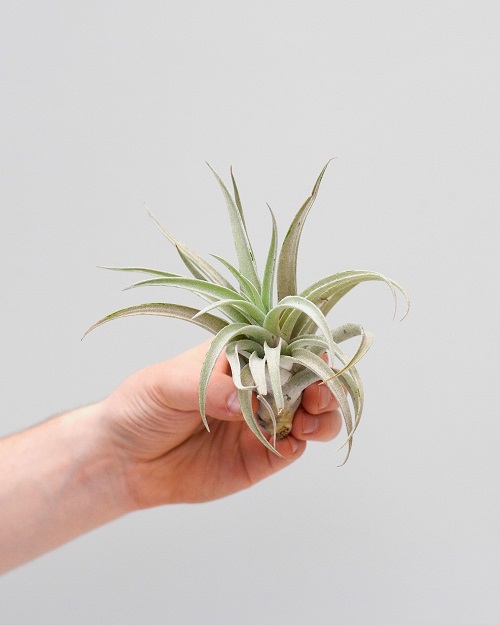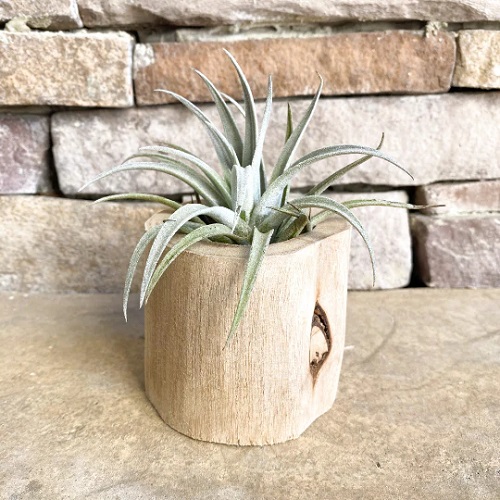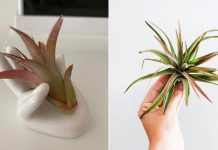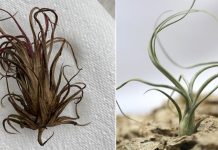Read this Harrisii Air Plant Care Guide and learn how to nurture this tillandsia for vibrant growth and long-lasting beauty.
Follow this Harrisii Air Plant Care Guide and find essential tips and insights to ensure your tillandsia thrives. Whether you’re a beginner or an experienced plant enthusiast, our guide will help you keep your air plant healthy, vibrant, and a beautiful addition to your space.
Check out Butzii Air Plant Growing Guide here
Harrisii Air Plant Information

The Harrisii Air Plant (Tillandsia harrisii) belongs to the Bromeliaceae family. These air plants are native to the southeastern United States, particularly in Florida, where they can grow in subtropical and tropical regions.
In terms of appearance, Harrisii Air Plants are small and compact, with slender, silvery-green leaves that form a rosette shape. They are relatively small, typically growing to a height of around 4 to 6 inches (10 to 15 cm) and having a similar spread.
The growth rate of Harrisii Air Plants is relatively slow, and they tend to produce offsets, or “pups,” at their base as they mature. These offsets can eventually grow into new plants.
When it comes to flowers, Harrisii Air Plants produce small, inconspicuous blooms that are typically pale in color, such as white or pale lavender. The flowers emerge from the center of the rosette and can be quite fragrant, although the scent is not particularly strong.
In terms of foliage, Harrisii Air Plants have slender, curved leaves that are covered in fine trichomes (small hair-like structures). These trichomes help the plant absorb moisture and nutrients from the air, as these plants are epiphytic, meaning they grow on other surfaces, like trees, without soil.
For optimal growth, Harrisii Air Plants require bright, indirect light and regular misting or soaking to provide the necessary moisture. They are low-maintenance plants that can be a unique and interesting addition to your indoor plant collection.
Check out Air Plant Juncea Care here
Harrisii Air Plant Propagation
Propagation methods for Tillandsia Harrisii (Harrisii Air Plant):
- Offsets
- Seeds
- Pup Division
Propagation of Tillandsia Harrisii through offsets is generally considered the easiest method for this type of air plant. Here’s a detailed explanation of how to propagate it using offsets:
- Offsets are small plantlets that grow at the base of the parent Tillandsia Harrisii. They usually appear after the plant has bloomed.
- Carefully remove the parent plant from its growing surface or substrate. Gently shake or tap it to dislodge any loose offsets.
- Using your fingers or a clean, sharp tool (like scissors or gardening shears), gently separate the offset from the parent plant. Be careful not to damage the offset or its roots during this process.
- Place the separated offset in a dry and well-ventilated area for a few hours or overnight. Allowing the cut surface to dry helps prevent rotting.
- After the offset has dried, you can plant it in a suitable growing medium or substrate.
- Tillandsia Harrisii is an epiphytic air plant, so it can be attached to a piece of wood, cork, or other decorative surfaces.
- You can also mount it on a wire or place it in a hanging planter. Ensure good air circulation around the plant.
- After planting, mist the offset lightly with water. You can also soak it in water for about 20-30 minutes once a week.
- Ensure that excess water can drain away to prevent waterlogged roots.
- Place the propagated offset in a location with bright, indirect light. Avoid direct sunlight, as it can scorch the plant.
- Maintain appropriate humidity levels by misting regularly, especially in dry indoor environments.
- With proper care, the offset will grow and mature into a new Tillandsia Harrisii plant over time. Be patient, as air plants can have slow growth.
Find Do Air Plants Need Sun? here
How to Display Harrisii Air Plant
1. Hanging Glass Globes:
- Suspend your air plant inside glass terrariums or hanging globes.
- Add decorative stones or colored sand at the bottom for a visually appealing look.
2. Wall-Mounted Frames:
- Attach air plants to a wooden frame or shadow box and hang it on your wall.
- Arrange them in a visually pleasing pattern for a living wall art piece.
3. Seashell Planters:
- Place your air plant inside large seashells or conch shells for a coastal-inspired display.
4. Driftwood and Branches:
- Secure air plants to pieces of driftwood or branches for a rustic and natural look.
- Hang the driftwood on the wall or place it in a decorative vase.
5. Geometric Planters:
- Use geometric-shaped planters made of metal or ceramic to house your air plant.
- Create a stylish and modern arrangement with different geometric containers.
6. Macramé Hangers:
- Hang air plants in decorative macramé plant hangers for a bohemian touch.
These hangers can be suspended from hooks or curtain rods.
7. Miniature Fairy Gardens:
- Incorporate your air plant into a miniature fairy garden with tiny figurines, fairy houses, and small stones.
8. Floating Planters:
- Place air plants in clear glass or acrylic containers filled with water and suspend them from the ceiling.
- It creates a stunning floating effect.
9. Magnetic Planters:
- Attach small, magnetic planters to metal surfaces like your fridge or a magnetic board.
- Display multiple air plants in a space-saving manner.
10. Terrarium Bowls:
Arrange air plants with colorful sand, pebbles, or decorative moss inside glass or ceramic bowls.
Check Amazing Benefits of Air Plants here
Feeding Harrisii Air Plant
Feed Tillandsia Harrisii by misting it with a diluted, water-soluble orchid or bromeliad fertilizer every 3-4 weeks during the growing season (spring and summer). Ensure the plant is thoroughly wetted but not soaked. Shake off excess water to prevent rot. In winter, reduce fertilization to once every 2-3 months as the plant’s growth slows. Proper feeding supports healthy growth and vibrant coloring.
Explore The Best Jellyfish Air Plant Care Guide on The Internet here
Harrisii Air Plant Care
Position
Position your Harrisii Air Plant in bright, indirect light. Place it near a window with filtered sunlight or artificial light sources, but avoid direct sunlight, which can scorch the plant. Adequate light is essential for its health, growth, and the development of its unique silvery-green foliage.
Airflow
Ensure good airflow for your Harrisii Air Plant to prevent moisture buildup and rot. Place it in an area with gentle, consistent air circulation. Avoid enclosed spaces with stagnant air. Proper airflow supports optimal health by allowing the plant to dry quickly after watering and prevents fungal issues.
Water
Harrisii Air Plant requires a unique watering routine. Submerge the plant in room-temperature water for 20-30 minutes once a week. Afterward, allow it to dry thoroughly to prevent rot. In dry climates or seasons, mist the plant 2-3 times a week. Adjust watering frequency based on environmental conditions to maintain healthy hydration.
Temperature
Maintain temperatures between 50-90°F (10-32°C) for Harrisii Air Plant. It thrives in a moderate to warm climate. Protect it from frost and extreme cold, as freezing temperatures can harm the plant. Keep it within this temperature range for optimal health and growth, ensuring it’s not exposed to prolonged cold or excessive heat.
Pests and Diseases
Tillandsia Harrisii is generally resilient but can occasionally face pests like mealybugs and aphids. Remove pests manually or treat them with insecticidal soap. Overwatering can lead to root rot. Ensure proper ventilation to prevent fungal issues. Inspect regularly, maintain a dry environment, and address any problems promptly for healthy growth.
Discover Air Plant Care here
Frequently Asked Questions- Harrisii Air Plant Care Guide
1. How often should I water my Harrisii Air Plant?
Water your Harrisii Air Plant by submerging it in room-temperature water for 20-30 minutes once a week. Adjust the frequency based on humidity levels and climate.
2. What type of light does the Harrisii Air Plant need?
Provide bright, indirect light. Place it near a window with filtered sunlight or use artificial light sources. Avoid direct sunlight to prevent scorching.
3. Do I need to fertilize my Harrisii Air Plant?
Yes, use a diluted, water-soluble orchid or bromeliad fertilizer every 3-4 weeks during the growing season (spring and summer). Reduce fertilization in winter to every 2-3 months.
4. How do I display my Harrisii Air Plant creatively?
You can display it in hanging glass globes, on driftwood, in geometric planters, and in many other creative ways. Experiment to match your style and decor.






